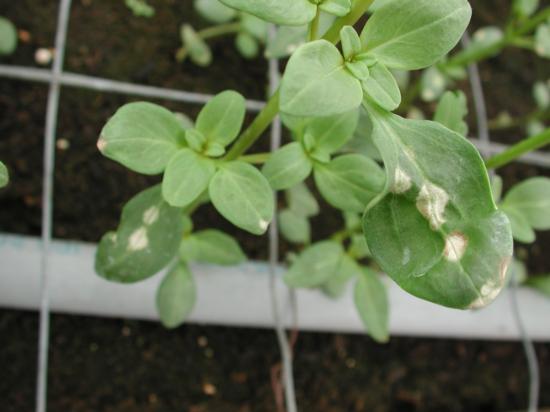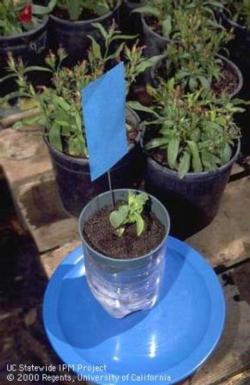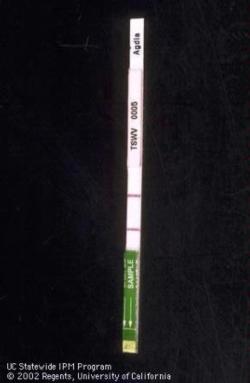DISEASE FOCUS: Insect-transmitted plant virus diseases
by Deborah M. Mathews
This new column in the UCNFA newsletter will focus on various aspects of plant diseases, including new disease reports, emerging threats to the ornamental industry, as well as control and management strategies. In the next UCNFA issue, I will be discussing new diseases to watch out for and the return of some old pathogen problems. But in keeping with the insect theme, this issue will focus on virus diseases that are transmitted by insect pests.
There are many reasons to control insect populations in plant production facilities, not only to prevent damage from the insects themselves, but also to avoid subsequent infection by viruses. Further, although this article focuses on insect-transmitted virus diseases, there have been several reports of viable spores of fungal and oomycete plant pathogens (e.g., Fusarium, Verticillium, Thielaviopsis, Pythium and Phytophthora) being ingested and moved by such insects as shore flies and fungus gnats, common greenhouse invaders.
Thrips Transmission
Two of the most common virus diseases facing greenhouse operations today are members of a virus family collectively called the tospoviruses: impatiens necrotic spot virus (INSV) and tomato spotted wilt virus (TSWV). INSV is more prevalent in ornamentals (fig.1), while TSWV is more often found in vegetable crops. However, both viruses can infect hundreds of different plant species, and plants with mixed infections of both viruses are not uncommon.

Fig. 1. Viral lesions caused by impatiens necrotic spot virus on snapdragon seedlings. Photo by S. Tjosvold.
These tospoviruses are moved by vegetative propagation of plants and can be mechanically transmitted, but by far the most important mode of transmission is by thrips. The prevalence of western flower thrips, Frankliniella occidentalis, in California has helped lead to an increase in the incidence of these viruses. The insect vector-virus relationship is quite complex in that only the juvenile larval stages of thrips can acquire the viruses (the first instar is primarily responsible, the second instar acquires rather inefficiently). Juvenile larval stages that acquire the disease must then undergo their non-feeding pupal stages and emerge as adults before they can transmit the viruses to new plants. The entire progression takes about 1 to 2 weeks from egg to adult, depending on temperature. Once acquired in this manner, the adults can transmit the viruses for the rest of their life span (about 30 to 35 days), although adults do not pass the virus through to their eggs. Interestingly, adults that have not acquired the virus that feed on infected plants cannot transmit the viruses to new plants, even though the virus may be detected within the insects themselves.
Therefore, virus management depends greatly on thrips management: if thrips reproduction can be prevented, juveniles will not be available for virus acquisition, and viruliferous adults (those able to transmit the virus) will not be produced. Fine mesh screening for thrips exclusion on greenhouse vents and other openings can prevent thrips that have obtained INSV and/or TSWV from weeds or field crops outside from entering the facility and inoculating plants. A good scouting and trapping routine for thrips detection (fig. 2) and chemical application and rotation schedules for thrips control round out an integrated management program. There are easy-to-use “dipstick” type detection systems (fig. 3) available for INSV and TSWV that take only 5 to 10 minutes to get a result (e.g., Immunostrips from Agdia Inc., Elkhart, IN). If these viruses are an ongoing problem in your facility, you may consider adding this type of early detection system so infected plants may be identified and discarded before virus spread can occur.

Fig. 2. A monitoring program for tospoviruses should include a petunia indicator plant (shown in a self-watering pot on a blue plate with nonsticky blue cards to attract thrips).
Petunia indicator plants show distinctive local lesions when infective thrips feed on them. These plants do not support thrips development and seldom become systemically infected.
Photo by Jack Kelly Clark

Fig. 3. Test strip from a kit for detecting viruses in plants.
A positive result on a strip specific for tomato spotted wilt virus is shown.
Photo by Jack Kelly Clark.
Aphid Transmission
Aphids are able to transmit over 300 plant viruses including cucumber mosaic virus (CMV) and about 100 different members of the potato virus Y group, known generically as potyviruses. CMV can infect over 900 plant species, while most potyviruses have more limited host ranges. Usually the aphids are able to transmit these viruses almost immediately after feeding on infected plants, but unlike the tospovirus/thrips relationship described above, they lose the ability to transmit the virus after just a few minutes or hours and must reacquire virus particles to continue to transmit them. Tobacco mosaic virus (TMV) is not classically vectored by any insect through feeding. However, it has been shown that this readily mechanically transmissible virus can be transmitted by aphids that walk on infected leaves and pick up virus particles on their legs, then fly to new plants and move around on the foliage, thus inoculating these plants with TMV. Outbreaks of large numbers of aphids are somewhat rare inside greenhouses, but field crops or outdoor nursery crops face more of a threat from viruses transmitted by aphids.
Whitefly Transmission
Whiteflies are also very efficient vectors of about 115 plant viruses. Common vectors are greenhouse whitefly (Trialeurodes vaporariorum) and silverleaf whitefly (Bemisia argentifolii [= Bemisia tabaci B-biotype]). Fortunately, most of these viruses affect mainly vegetable crops, but as it becomes more common to grow tomatoes and peppers alongside ornamental plants, we may start to see more problems in our industry. Whitefly transmission varies with the insect species and the virus, but generally they are able to acquire the virus at the nymph and adult stages in as little as an hour, and then they can transmit the virus for days or weeks. As with thrips, the increase in pest infestations and the development of pesticide-resistant populations in recent years has made the role of whiteflies in virus transmission more important.
Deborah Mathews is UC Cooperative Extension Specialist/Plant Pathologist for Ornamental Crops, Department of Plant Pathology and Microbiology, UC Riverside.












